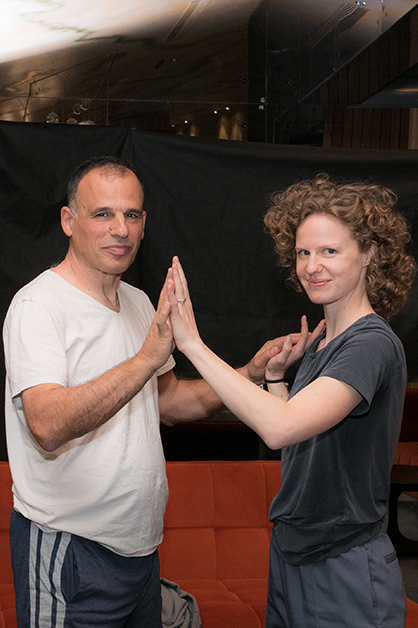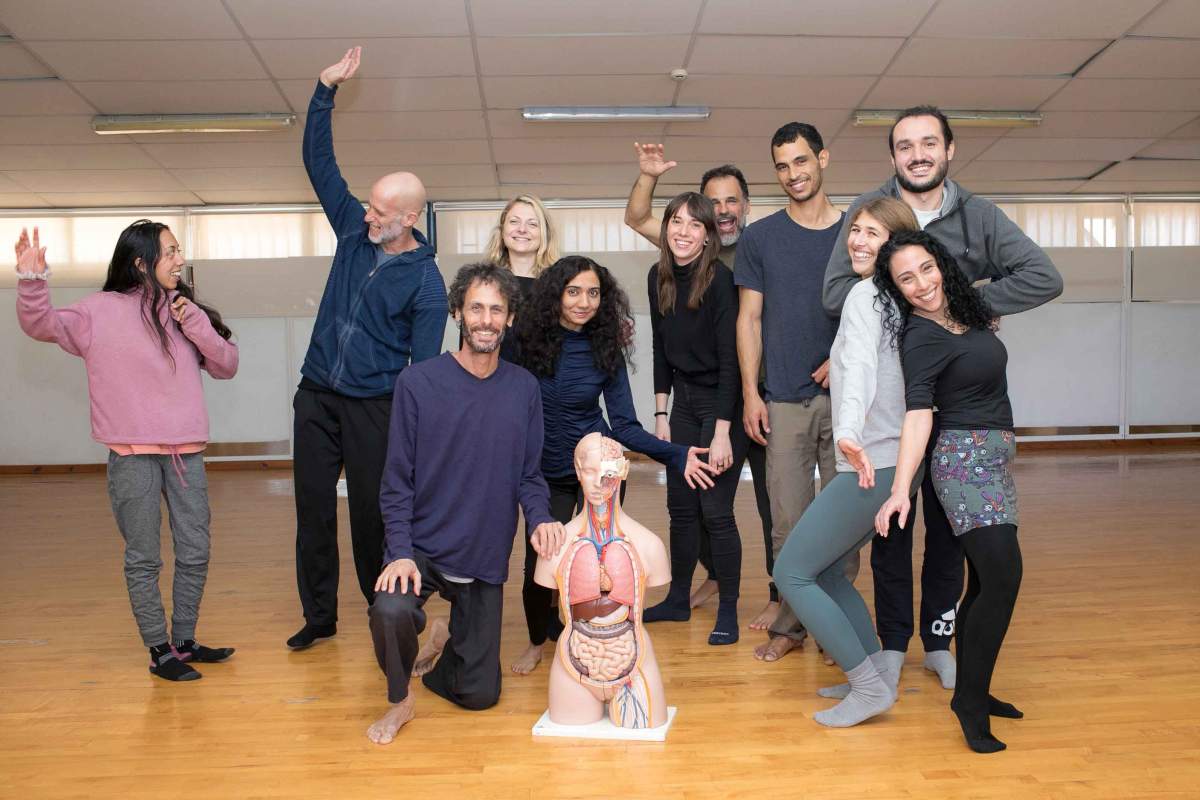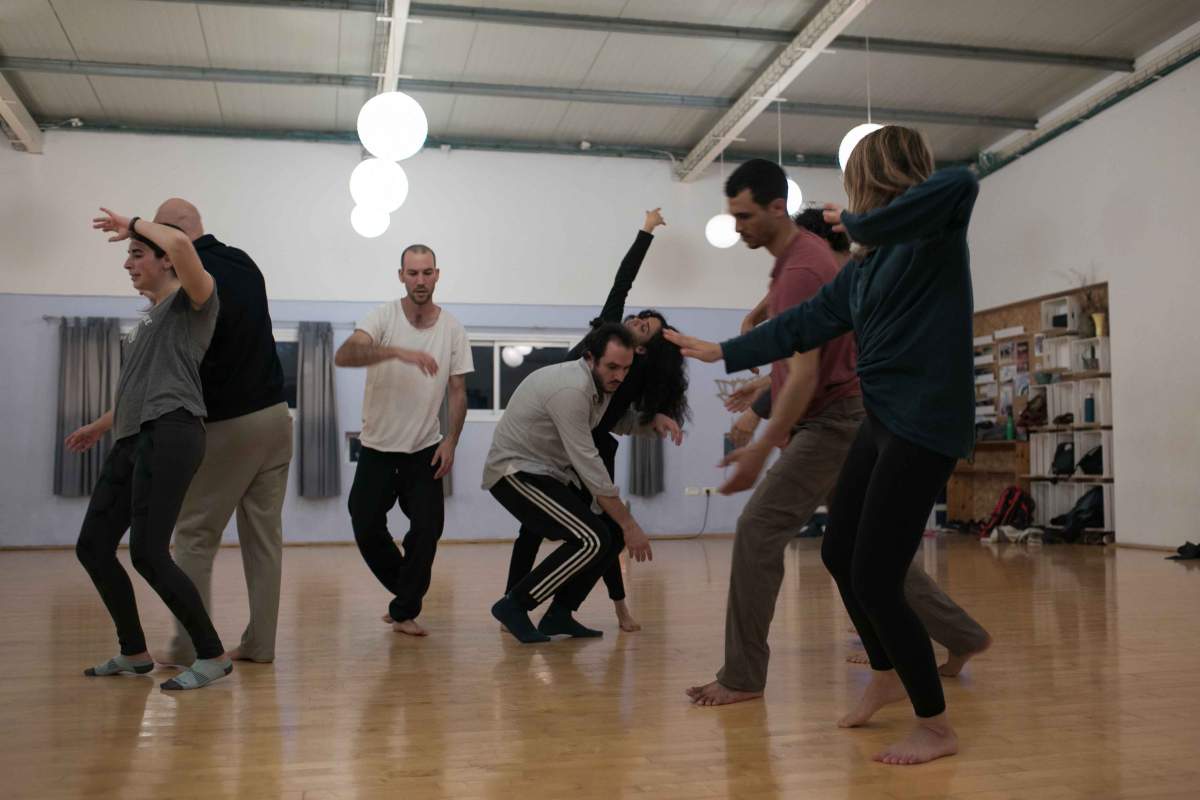Are you a journalist? Please sign up here for our press releases
Subscribe to our monthly newsletter:
Five years ago, Atan Gross, a 58-year-old father of two boys, Gil and Eyal, received unsettling news: He had Parkinson’s disease. But Gross, a professor of biology at the Weizmann Institute of Science, was unfazed by this diagnosis. Turning to science and his other great passion, dance, for inspiration and the fortitude he needs to fight this neurodegenerative disorder as both a researcher and a patient, he continues to innovate.
Some of the fruits of Prof. Gross’s labor of love were on display recently at the Weizmann Institute, where he gave his first dance performance – a lifelong dream that he decided to prioritize after the diagnosis. Titled Encounter, the 30-minute duet was created with the Austrian dancer Olivia Hild and features elements inspired by Gross’s life and work. During the recent show at the Michael Sela Auditorium on the Weizmann Institute’s campus in Rehovot, near Tel Aviv, screens around the performance area featured high-magnification footage of mitochondria – organelles that produce energy for the body’s cells – which have been the focus of Prof. Gross’s work as a biologist.

Parkinson’s disease was, literally, also part of the show: Prof. Gross decided to incorporate his hand tremors into the performance. “There’s a recurrent movement in the show, which became part of the choreography, in which I bend the shaking hand with the other hand, soothing it that way,” he says. “As a person who’s very connected to his body and its movement, I find ways of coping with the disease through dance. I don’t hide the shaking in my hand. It’s a part of me. It’s even an inseparable part of my dance. It’s a dancing, shaking, living body.”
Dance has been a part of Prof. Gross’s life since around the time he began studying cells when he was in his early 20s. He has been dancing every day for decades. Performing his own dance, however, had remained a dream – until he received the diagnosis.
“When I was diagnosed, it was a relief. I had known for some time that something was wrong, and here I finally knew what it was I had to fight. I decided I wanted to realize my dreams, and one of them was to perform my own dance, to dance science and to dance my art,” he says.
The performance had to take place in an intimate setting, Gross said, so the audience needed to be closer to the performers than they would be to those on a stage. He had a special linoleum floor installed for the show, and the spectators were seated on the ground around the two performers. “The beauty of the dance that came from this was its flow, the continuity, and the unmediated connection between the dancers, which led to confidence that the next movement will happen on its own, even if we don’t know what it will be,” he recalls.
"As a person who’s very connected to his body and its movement, I find ways of coping with the disease through dance. I don’t hide the shaking in my hand. It’s a part of me. It’s even an inseparable part of my dance. It’s a dancing, shaking, living body"
Dance is a way for Prof. Gross to fight Parkinson’s disease as a patient. But he also uses science to do so as a researcher. Several years ago, in his lab at the Weizmann Institute’s Immunology and Regenerative Biology Department, Prof. Gross started researching how mitochondrial fatigue is connected to Parkinson’s. He states, however, that his main scientific passion is to understand the relationship between mitochondria metabolism and programmed cell death, or apoptosis, and their relation to disease.

Understanding how movement inspires scientific work has occupied Gross for many years. He has led multiple collaborations at the Weizmann Institute involving dance, including movement workshops for Weizmann Institute scientists, led by the Batsheva Dance Company, as well as lectures on the subject and joint projects. Gross developed a class for students at the Weizmann Institute’s Feinberg Graduate School titled TNUDA (a mashup of the Hebrew words for movement and science). It explored the connection between science and movement and was hosted by dancer and choreographer Shahar Binyamini, who recently participated in the institute’s first artist residency program, during which he created a performance titled Evolve.
Last year, Gross initiated a new class for students called SENSCIENCE (combining the words sensation and science), which aims to help develop new ways of thinking in science through the subjective body experience that occurs during movement. Prof. Gross was inspired to create the class by his instructor, Michael Shachrur, an expert in Body Mind Centering (BMC), a modality centered around lived anatomy and developmental movement.
Shachrur gave the course with Noam Carmeli – both are world experts in movement improvisation and contact improvisation. Prof. Gross also took part in the course, sharing his scientific insights and how he uses movement improvisation to develop new research angles. Fifteen students from across various faculties signed up for the course in the first semester, and five more joined for the second one. The course, which is continuing this year, aims to encourage the students to harness the insights they have during sessions and use them to explore new research perspectives in the lab.
Gross readily acknowledges that it takes some adjustment to go from lab work to dance mode. He’s honed this ability recently, while preparing for his first dance performance with Hild, his partner in the duet. The pair hammered out the details for the show over video chat during the COVID-19 pandemic. When international travel resumed, Hild came to the Weizmann Institute to work on the show. Gross then traveled to Austria for additional fine-tuning with Hild. It was the first time in many years that he had focused primarily and intensively on dancing – and it required some getting used to.
“As a scientist who’s used to coming to the lab every day and focusing on research, it was a unique experience for me to work at the studio for the whole day and create a dance show this way. It was very different from my lifestyle as a researcher,” recalls Gross.
The students involved in SENSCIENCE share Gross’s excitement for combining the two disciplines. “The process we go through connects us to worlds we’ve never experienced before,” says Dr. Francesco Greco, a postdoctoral fellow at the Weizmann Institute’s Scientific Archaeology Unit. “It sharpens the senses and helps with finding new ways of working with lab instruments, to better appreciate what we see through the microscope and to be more connected to the experiments we perform.”

Currently, Prof. Gross, Carmeli and Dr. Vered Aviv are developing a new course called Move Weizmann, a collaboration between the Jerusalem Academy of Music and Dance and the Weizmann Institute. “It exposes dance students to the world of science, and that’s another way of connecting the two,” Prof. Gross explains. In Move Weizmann, five professors from various research fields at the institute – Prof. Vered Rom-Kedar (mathematics); Prof. Ranny Budnik (physics); Prof. Amnon Horovitz (chemistry) and Profs. Gad Asher and Atan Gross (biology) – gave lectures to students pursuing a master’s degree in dance and to students at the institute. The lecturers will also participate in creating new dance pieces.
“The goal of all of these encounters and activities is to inspire the scientists conducting research at the Weizmann Institute,” Prof. Gross said. “Perhaps, if we try to feel the processes taking place inside our bodies when we move, we will get new ideas for our research.”